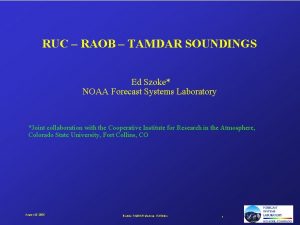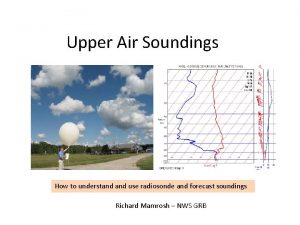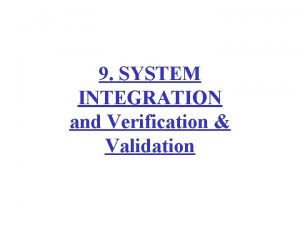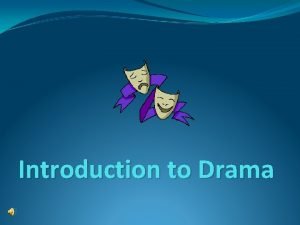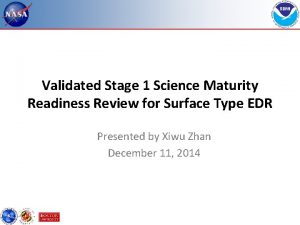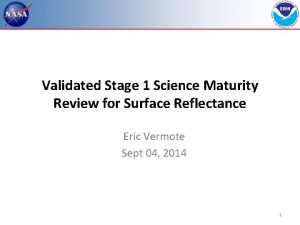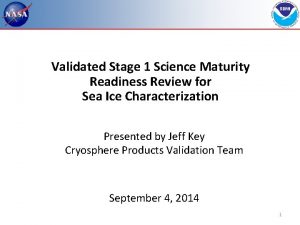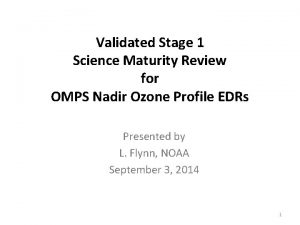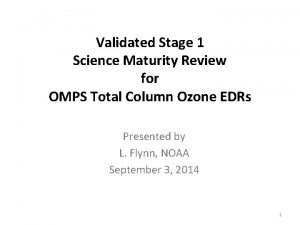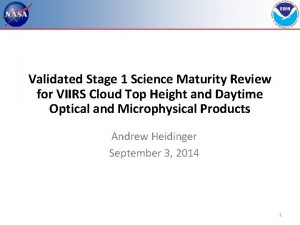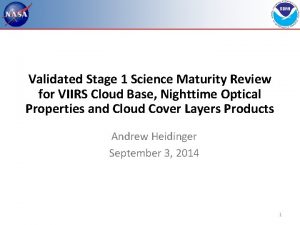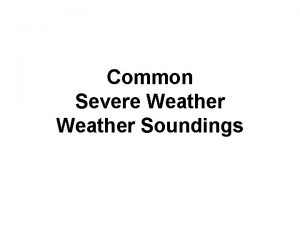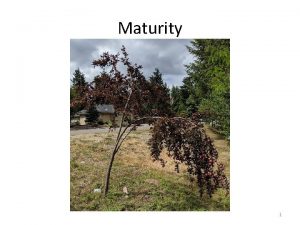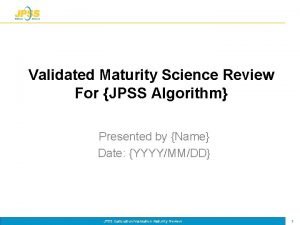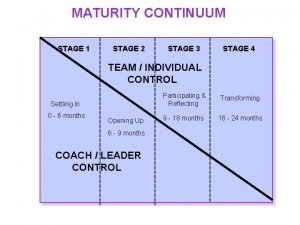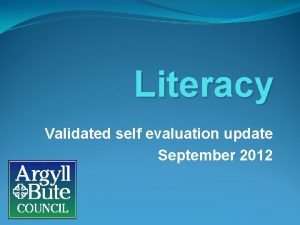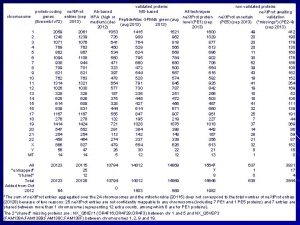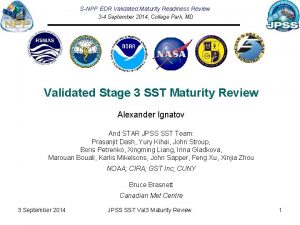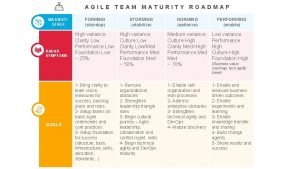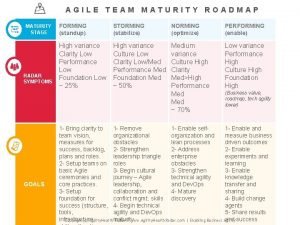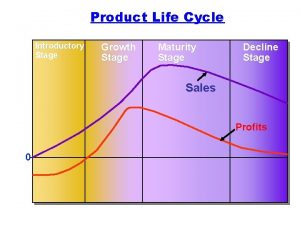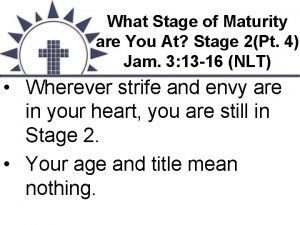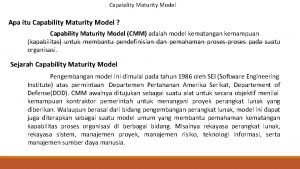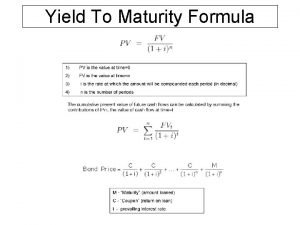Validated Stage 1 Science Maturity Review for Soundings



















































- Slides: 51

Validated Stage 1 Science Maturity Review for Soundings Presented by Quanhua (Mark) Liu September 3, 2014 1

Outline • Algorithm Cal/Val Team Members • Product Requirements • Evaluation of algorithm performance to specification requirements – Evaluation of the effect of required algorithm inputs – Quality flag analysis/validation – Error Budget • Documentation • Identification of Processing Environment • Users & User Feedback • Conclusion • Path Forward 2

Sounding EDR Cal/Val Team Name Organization Major Task M. Liu, T. Reale, W. Wolf NOAA/STAR Management leads A. Gambacorta IMSG@STAR NUCAPS algorithm lead, X. Xiong, C. Tan, F. Iturbide-Sanchez, K. Zhang: NUCAPS algorithm team member AVTP, AVMP, O 3, OLR, trace gases N. Nalli IMSG@STAR NUCAPS product validation lead C. Barnet STC NOAA Cr. IS/ATMS EDRs in complex weather regimes B. Sun, M. Pettey, Frank Tilley, Charlie Brown IMSG@STAR NPROVS/NPROVS+ X. Liu NASA/La. RC NUCAPS independent assessment P. J. Mather DOE support validation of EDRs D. Tobin UW ARM-RAOBS at NWP, SGP, NSA Special thanks to T. King, M. Wilson, and Y. Zhou. NUCAPS codes are now under version control in Clear. Case. 3

Temperature Profile Requirements Attribute L 1 RD p 43 Threshold Objective Geographic coverage 90% every 18 hours > 90% Vertical Coverage Surface to 0. 5 mb Vertical Cell Size 0. 2 ~50 mb 0. 1 ~ 10 mb Horizontal Cell Size 50 km at nadir 1 km at nadir Mapping Uncertainty 5 km 0. 5 km Measurement Range Propose 150 ~ 400 K Propose 100 ~ 500 K Cloud < 50%: Surface to 300 mb 1. 6 K per km layer 0. 5 K per km layer 300 to 30 mb 1. 5 K per 3 km layer 0. 5 K per 3 km layer 30 to 1 mb 1. 5 K per 5 km layer 0. 5 K per 5 km layer 1 to 0. 5 mb 3. 5 K per 5 km layer 0. 5 K per 5 km layer Measurement Uncertainty IR + MW MW only Cloud >= 50%: Surface to 700 mb 2. 5 K per km layer 0. 5 K per km layer 700 to 300 mb 1. 5 K per km layer 0. 5 K per km layer 300 to 30 mb 1. 5 K per 3 km layer 0. 5 K per 3 km layer 30 to 1 mb 1. 5 K per 5 km layer 0. 5 K per 5 km layer 1 to 0. 5 mb 3. 5 K per 5 km layer 0. 5 K per 5 km layer 4

Moisture Profile Requirements Attribute L 1 RD p 41 IR + MW MW only Threshold Objective Geographic coverage 90% every 18 hours 3 hrs Vertical Coverage Surface to 0. 5 mb Vertical Cell Size 20 ~50 mb 5 ~ 10 mb Horizontal Cell Size 50 km at nadir 1 km at nadir Mapping Uncertainty 5 km 0. 5 km Measurement Range Propose 0. 001 ~ 100 g/kg Measurement Uncertainty Expressed as a percent of average ratio in 2 km layers Cloud < 50%: Surface to 600 mb Greater of 20% or 0. 2 g/kg 10% 600 to 300 mb Greater of 35% or 0. 1 g/kg 10% 300 to 100 mb Greater of 35% or 0. 1 g/kg 10% Cloud >= 50%: Surface to 600 mb Greater of 20% or 0. 2 g/kg 10% 600 to 300 mb Greater of 40% or 0. 1 g/kg 10% 300 to 100 mb Greater of 40% or 0. 1 g/kg 10% 5

NOAA Unique Cr. IS/ATMS Processing System (NUCAPS) Retrieval System Antonia Gambacorta and Chris Barnet, 2012: 10. 1109/TGRS. 2012. 2220369.

Cloud Coverage, May 12, 2014 from STAR ICVS Clear 1 -10 10 -20 20 -30 30 -40 40 -50 50 -60 60 -70 70 -80 80 -90 90 -99 100% Cloud coverage = 57% 8. 61 13. 92 6. 16 5. 67 4. 52 3. 94 3. 68 3. 80 4. 32 8. 66 18. 28 18. 44 Data from Haibing Sun CCR (CF< 80%) Using cloud-clearing radiance, IR retrieval data increases from 8. 6% to 55%.

Validation Methodology, NPROVS and VALAR Numerical Model (e. g. , ECMWF, NCEP/GFS) Global Comparisons Large, global samples acquired from Focus Days Useful for early sanity checks, bias tuning and regression However, not independent truth data Satellite EDR (e. g. , Cr. IS, AIRS, ATOVS, COSMIC) Intercomparisons Global samples acquired from Focus Days (e. g. , Cr. IS/ATMS) Consistency checks; merits of different retrieval algorithms However, IR sounders have similar error characteristics; must take rigorous account of averaging kernels of both systems (e. g. , Rodgers and Connor, 2003) Conventional RAOB Matchup Assessments Conventional WMO/GTS operational sondes launched ~2/day for NWP (e. g. , NPROVS) Useful for representation of global zones and long-term monitoring Large statistical samples acquired after a couple months’ accumulation Limitations: • Skewed distribution toward NH-continental sites • Significant mismatch errors, potentially systematic at individual sites • Non-uniform, less-accurate and poorly characterized • radiosonde types used in data sample Nalli et al. , 2013: JGR; Dedicated/Reference RAOB Matchup Assessments Dedicated for the purpose of satellite validation Well-specified error characteristics and optimal accuracy Minimal mismatch errors Include atmospheric state “best estimates” or “merged soundings” Reference sondes: CFH, corrected RS 92, Vaisala RR 01 under Development Traceable measurement Detailed performance specification and regional Characterization Limitation: Small sample sizes and geographic coverage E. g. , ARM sites (e. g. , Tobin et al. , 2006), GRUAN sites, NOAA AEROSE Intensive Field Campaign Dissections Include dedicated RAOBs, especially those not assimilated nto NWP models Include ancillary datasets (e. g. , ozonesondes, lidar, M-AERI, MWR, sunphotometer, etc. ) Ideally include funded aircraft campaign using aircraft IR sounder (e. g. , NAST-I, S-HIS) underflights Detailed performance specification; state specification; SDR cal/val; EDR “dissections” E. g. , AEROSE, JAIVEX, WAVES, AWEX-G, EAQUATE, Cal. Water 2 Divakarla, et al. , 2014: JGR-Atmosphere. 8

9

Data Product Maturity Definition Validated Stage 1: Using a limited set of samples, the algorithm output is shown to meet the threshold performance attributes identified in the JPSS Level 1 Requirements Supplement with the exception of the S-NPP Performance Exclusions. Validation Data Set Qualitative Analysis Product global distribution Quantitative Analysis a. Aerosols and Ocean Science Expeditions (AEROSE) b. ECMWF Global Analysis c. Dedicated radiosondes ARM-SGP : Mid-latitude land ARM-TWP: Tropical western pacific ARM-NSA: Polar area NUCAPS Products 10

NUCAPS vs ECMWF, T and H 2 O Black indicate where IR+MW and MW-only failed qc … 11

Dedicated and GRUAN Reference RAOB JPSS S-NPP Dedicated GRUAN Reference Sites (NPROVS+ Collocation) Location Lat (deg) Lon(deg) RAOB Site Lat (deg) Lon (deg) ARM-SGP 36. 6 -97. 5 ARM-NSA 71. 3 -156. 6 ARM-TWP 2. 06 147. 43 PMRF 22. 05 -159. 78 BCCS 39. 05 -76. 88 AEROSE Tropical Ocean BEL 39. 05 -76. 88 BOU CAB 39. 95 52. 1 -105. 2 5. 18 NSA NYA OUA 71. 32 78. 92 12. 4 -156. 6 11. 92 -1. 5 DAR -12. 475 130. 83 PAY 46. 81 6. 95 ENA 39. 05 -28. 03 POT 40. 6 15. 72 ERK 79. 98 -85. 93 GAN -0. 69 73. 15 REU SRC -21. 08 -0. 9 55. 38 -89. 6 HIH 19. 72 -155. 05 SGP 36. 61 -97. 49 LAU -45. 04 169. 68 LIN 52. 22 14. 12 SOD TAT 67. 37 36. 06 26. 63 140. 1 MAN -2. 06 147. 43 TMF 34. 39 -117. 7 12 NAU -0. 52 166. 92 XIL 43. 95 116. 12

2013 AEROSE State Parameters P(z), T(p), U(p), O 3(p), Ts , us , vs , AOD 13

NDE-OPS IR + MW MOD=ECMWF Temperature Moisture Standard tropical water vapor profile 14

Offline IR + MW Temperature 27 August 2014 Nalli et al. - STAR VALAR Moisture 15

Offline MW-Only (MIT) Temperature 27 August 2014 Nalli et al. - STAR VALAR Moisture 16

NUCAPS MW+IR & MW Only Global (land+ocean) vs ECMWF Analysis (focus day 2012 -05 -15) JPSS L 1 RD: (see next slide) 30 – 300 mb 1. 042 K (Req: 1. 5 K) TOA – 700 mb 1. 88 K (Req: 1. 5 K) 300 -SURF 1. 34 K (Req: 1. 6 K) 700 -SURF 2. 68 K (Req: 2. 5 K) 100 – 600 mb 23. 3% (Req: 35%) 32. 2% (Req: 40%) 600 -SURF 19. 8% (Req: 20%) 23. 6% (Req: 20%)

Summary on GLOBAL validation vs ECMWF green = passed yellow = close red = failed SUMMARY ON MW+IR RESULTS vs JPSS L 1 RD REQUIREMENTS RESULTS JPSS L 1 RD 30 – 300 mb 1. 04 K 1. 5 K 300 mb - SURF 1. 34 K 1. 6 K MW+IR TEMPERATURE RESULTS JPSS L 1 RD 100 - 600 mb 23. 3% 35% 600 mb -SURF 19. 8% 20% MW+IR WATER VAPOR SUMMARY ON MW-ONLY RESULTS vs JPSS L 1 RD REQUIREMENTS RESULTS JPSS L 1 RD 30 – 700 mb 1. 88 K 1. 5 K 700 mb - SURF 2. 68 K 2. 5 K MW-ONLY TEMPERATURE RESULTS JPSS L 1 RD 100 - 600 mb 32. 2% 40% 600 mb -SURF 23. 6% 20% MW-ONLY WATER VAPOR • NUCAPS MW+IR fully meets requirements globally • NUCAPS MW-Only is close to fully meets spec. • Possible isues are: • Residual temporal and spatial mismatch between retrievals and model: ECMWF mismatch is +/- 1. 5 hour and +/0. 25 deg and we use both forecast and analysis depending on UT time. • Uncertainty in the model • Uncertainty in the retrievals • Ongoing NUCAPS improvement activity: • Improve NUCAPS look up tables (RTA tuning and first guess) • Improve validation methodology by using dedicated RAOBs: see ahead 18

GLOBAL OCEAN VALIDATION NUCAPS MW+IR vs ECMWF Analysis (focus day 2012 -05 -15) SUMMARY ON OCEAN MW+IR RESULTS vs JPSS L 1 RD REQUIREMENTS RESULTS JPSS L 1 RD 30 – 300 mb 1. 02 K 1. 5 K 300 mb - SURF 1. 20 K 1. 6 K MW+IR TEMPERATURE RESULTS JPSS L 1 RD 100 - 600 mb 23. 3% 35% 600 mb -SURF 19. 3% 20% MW+IR WATER VAPOR

GLOBAL OCEAN VALIDATION NUCAPS MW Only vs ECMWF Analysis (focus day 2012 -05 -15) SUMMARY ON OCEAN MW-ONLY RESULTS vs JPSS L 1 RD REQUIREMENTS RESULTS JPSS L 1 RD 30 – 700 mb 1. 55 K 1. 5 K 700 mb - SURF 2. 33 K 2. 5 K MW-ONLY TEMPERATURE RESULTS JPSS L 1 RD 100 - 600 mb 32. 4% 40% 600 mb -SURF 20. 7% 20% MW-ONLY WATER VAPOR

Summary on OCEAN validation vs ECMWF green = passed yellow = close red = failed SUMMARY ON OCEAN MW+IR RESULTS vs JPSS L 1 RD REQUIREMENTS RESULTS JPSS L 1 RD 30 – 300 mb 1. 02 K 1. 5 K 300 mb - SURF 1. 20 K 1. 6 K MW+IR TEMPERATURE RESULTS JPSS L 1 RD 100 - 600 mb 23. 3% 35% 600 mb -SURF 19. 3% 20% MW+IR WATER VAPOR SUMMARY ON OCEAN MW-ONLY RESULTS vs JPSS L 1 RD REQUIREMENTS RESULTS JPSS L 1 RD 30 – 700 mb 1. 55 K 1. 5 K 700 mb - SURF 2. 33 K 2. 5 K MW-ONLY TEMPERATURE RESULTS JPSS L 1 RD 100 - 600 mb 32. 4% 40% 600 mb -SURF 20. 7% 20% MW-ONLY WATER VAPOR • NUCAPS MW+IR fully meets requirements over ocean • NUCAPS MW-Only is close to fully meet spec. • Possible issues are: • Residual temporal and spatial mismatch between retrievals and model: ECMWF mismatch is +/- 1. 5 hour and +/0. 25 deg and we use both forecast and analysis depending on UT time. • Uncertainty in the ECMWF model • Uncertainty in the retrievals • Ongoing NUCAPS improvement activity: • Improve NUCAPS look up tables (RTA tuning and first guess) • Improve validation methodology by using dedicated RAOBs: see ahead 21

NUCAPS validation vs ARM • JPSS funded dedicated (time and location) wrt NPP • Global ensemble, ~ 3 month field campaign (2012): – Tropical Western Pacific (TWP) RAOB Site ARM-SGP – Southern Great Plans (SGP) ARM-NSA – North Slope of Alaska (NSA) ARM-TWP Lat (deg) Lon (deg) 36. 6 -97. 5 71. 3 -156. 6 2. 06 147. 43 22

NUCAPS MW+IR RMS Statistics vs ARM TWP, SGP, NSA Dedicated RAOBs SUMMARY ON MW+IR RESULTS vs JPSS L 1 RD REQUIREMENTS RESULTS JPSS L 1 RD 30 – 300 mb 1. 35 K 1. 5 K 300 mb - SURF 1. 25 K 1. 6 K MW+IR TEMPERATURE RESULTS JPSS L 1 RD 100 - 600 mb 28. 2% 35% 600 mb -SURF 21. 8% 20% MW+IR WATER VAPOR

NUCAPS MW Only RMS Statistics vs ARM TWP, SGP, NSA Dedicated RAOBs SUMMARY ON MW-ONLY RESULTS vs JPSS L 1 RD REQUIREMENTS RESULTS JPSS L 1 RD 30 – 700 mb 1. 59 K 1. 5 K 700 mb - SURF 2. 25 K 2. 5 K MW-ONLY TEMPERATURE RESULTS JPSS L 1 RD 100 - 600 mb 34. 8% 40% 600 mb -SURF 31. 1% 20% MW-ONLY WATER VAPOR

Summary on global validation vs ARM dedicated RAOBs green = passed yellow = close red = failed SUMMARY ON MW+IR RESULTS vs JPSS L 1 RD REQUIREMENTS RESULTS JPSS L 1 RD 30 – 300 mb 1. 35 K 1. 5 K 300 mb - SURF 1. 25 K 1. 6 K MW+IR TEMPERATURE RESULTS JPSS L 1 RD 100 - 600 mb 28. 2% 35% 600 mb -SURF 21. 8% 20% MW+IR WATER VAPOR SUMMARY ON MW-ONLY RESULTS vs JPSS L 1 RD REQUIREMENTS RESULTS JPSS L 1 RD 30 – 700 mb 1. 59 K 1. 5 K 700 mb - SURF 2. 25 K 2. 5 K MW-ONLY TEMPERATURE RESULTS JPSS L 1 RD 100 - 600 mb 34. 8% 40% 600 mb -SURF 31. 1% 20% MW-ONLY WATER VAPOR • The NUCAPS system meets requirements globally except for water vapor MW-only (31. 1% vs 20%) in the layer 600 mb – surface and the water vapor MW+IR (21. 8% vs 20%) in the layer 600 mb - surface. • Possible issues are: • Residual temporal and spatial mismatch (75 km) between retrievals and RAOBs considerably affects water vapor statistics (up to 10% due to 50 km mismatch, especially in the UTH due to RAOB drift) • Uncertainty in the RAOBs (supersaturation, calibration uncertainty) • Uncertainty in the retrievals: we are aware that there is a need for updating the look up tables and a possible bug in the MW-only retrieval module but just did not have enough time to fix it (ongoing NUCAPS improvement activity) 25

VALIDATION SUMMARY • NUCAPS MW+IR – meets requirements globally vs ECMWF – meets requirements over ocean vs ECMWF – Close to meet requirements globally and over selected areas vs Dedicated RAOBs • NUCAPS MW – Only – NUCAPS MW Only close to meet requirements globally vs ECMWF – NUCAPS MW only close to meet requirements over ocean vs ECMWF – meets requirements over tropical western pacific dedicated RAOBs • Present issues in the validation truth: – – • • • Residual temporal and spatial mismatch between retrievals and model: ECMWF mismatch is +/- 1. 5 hour and +/- 0. 25 deg and we use both forecast and analysis depending on UT time. Uncertainty in the ECMWF model Residual temporal and spatial mismatch (75 km) between retrievals and RAOBs considerably affects water vapor statistics (up to 10% due to 50 km mismatch, especially in the UTH due to RAOB drift) Uncertainty in the RAOBs (supersaturation, calibration uncertainty) Ongoing activity: – We are aware that there is a need for updating the look up tables for both the MW-Only and MW+IR retrieval: • A priori, First guess, radiance bias correction 26

Evaluation of the effect of required algorithm inputs (1) • Required Algorithm Inputs – Primary Sensor Data: Cr. IS, ATMS – Ancillary Data: GFS surface pressure – Upstream algorithms: UV O 3 – LUTs: ATMS bias correction Cr. IS bias correction Regression Coefficients for the first guess tuning parameters CRTM cloud and aerosol optical properties, surface emissivity, transmittance coefficients 27

Evaluation of the effect of required algorithm inputs (2) • Evaluation of the effect of required algorithm inputs – Study / test cases 1. Cr. IS/ATMS, IASI/AMSU/MHS 2. ECMWF global analysis and 6 h forecast 3. Conventional radiosondes 4. Trace gases from various sources 5. GFS surface pressure – Results 1. Cr. IS/ATMS 2. GFS global analysis 3. Dedicated radiosondes 4. Aerosols and Ocean Science Expeditions (AEROSE) 5. ECMWF global analysis 28

NUCAPS vs AIRS v 59 acceptance yield (blue = accepted red = rejected) NUCAPS AIRS v 59 • NUCAPS global acceptance yield is ~60% (focus day 2012/05/15) • AIRS v 59 global acceptance yield is ~75% (focus day 2012/05/15) • Ongoing activity: QA optimization reflecting instrument properties 29

Error Budget for Temperature Profile Attribute Analyzed L 1 RD Threshold Analysis/Valid ation Result Error Summary Geographic coverage 90% every 18 hours > 90% Vertical Coverage Surface to 0. 5 mb Surface to 0. 016 mb Vertical Cell Size 0. 2 ~50 mb 0. 2 ~ 30 mb Horizontal Cell Size 50 km at nadir Mapping Uncertainty 5 km Measurement Range Propose 150 ~ 400 K 200 ~ 310 K Cloud < 50%: Surface to 300 mb 1. 6 K per km layer 1. 34 K per km layer 1. 5 K per 3 km layer 1. 04 K per 3 km layer 1. 5 K per 5 km layer 1. 04 K per 5 km layer 1 to 0. 5 mb 3. 5 K per 5 km layer 1. 04 K per 5 km layer Cloud >= 50%: Surface to 700 mb 2. 5 K per km layer 2. 68 K per km layer NUCAPS MW only has tougher requirement than Mi. RS 3 K (sea clear), 5. 5 K (land) 700 to 300 mb 1. 5 K per km layer 1. 88 K per km layer Mi. RS 2 K (sea clear), 2. 5 K (land) 1. 5 K per 3 km layer 1. 88 K per 3 km layer Mi. RS 2 K 30 to 1 mb 1. 5 K per 5 km layer 1. 88 K per 5 km layer 1 to 0. 5 mb 3. 5 K per 5 km layer 1. 88 K per 5 km layer 300 to 30 mb IR + 30 to 1 mb MW MW only 300 to 30 mb Mi. RS Precision L 1 RD p 44 30

Error Budget for Moisture Profile Attribute Analyzed L 1 RD Threshold Analysis/Valid ation Result Error Summary Geographic coverage 90% every 18 hours > 90% Vertical Coverage Surface to 0. 5 mb Surface to 0. 016 mb Vertical Cell Size 0. 2 ~50 mb 0. 2 ~ 30 mb Horizontal Cell Size 50 km at nadir Mapping Uncertainty 5 km Cloud < 50%: Surface to 600 mb Greater of 20% or 0. 2 g/kg 19. 8% 600 to 300 mb Greater of 35% or 0. 1 g/kg 23. 3% Cloud >= 50%: Surface to 600 mb Greater of 20% or 0. 2 g/kg 23. 6% Mi. RS 36% (sea clear), 53% (land)* 600 to 400 mb Greater of 40% or 0. 1 g/kg 32. 2% Mi. RS 63% (sea ocean), 61% (land)* Greater of 40% or 0. 1 g/kg 32. 2% Mi. RS 67% (see clear), 67% (land)* IR + 300 to 100 mb MW MW only 400 to 100 mb * Mi. RS uncertainty is calculated from its precision and accuracy (see L 1 RD p 42). 31

Documentation • The following documents will be updated and provided to the EDR Review Board before AERB approval: – Current or updated ATBD YES – Current or updated OAD No, different documentation requirements specifically for SPSRB to support OSPO – README file for CLASS http: //gis. ncdc. noaa. gov/geoportal/catalog/search/resource/details. p age? id=gov. noaa. ncdc: C 00868 http: //www. ospo. noaa. gov/Products/atmosphere/soundings/nucaps/i ndex. html – Product User’s Guide (Recommended) NUCAPS External User Manual (Jan. 2013) 32

Identification of Processing Environment • IDPS or NDE build (version) number and effective date NDE, version 1. NOAA CLASS publicly released since April 8, 2014. • Algorithm version NUCAPS Version 1 • Version of LUTs used NUCAPS LUT version 1 • Version of PCTs used NA • Description of environment used to achieve validated stage 1 IBM at NOAA/OSPO Linux at NOAA/STAR 33

Users & User Feedback • User list NOAA CLASS AWIPS-II FNMOC – Fleet Numerical Meteorology and Oceanography Center Nowcasting Direct broadcast Support SDR data monitoring, retrieval products and SDR have the same time, the same location, and the same footprint. Ø Timely temperature and moisture profiles for the warning of severe weather (Mark De. Maria) , e. g. atmospheric stability condition for tropical storm. For tornado warning, retrieval products of higher spatial resolution (~ 10 km) is needed. Ø Basic and applied geophysical science research/investigation Ø E. g. , over 590 AIRS peer reviewed publications have appeared in the literature since launch of Aqua (Pagano et al. , 2013) Ø Ø Ø • Feedback from users Ø Two meetings with forecasters, color-coded flags to be done for AWIPS II • Downstream product list No • Reports from downstream product teams on the dependencies and impacts No 34

Support Cr. IS SDR • Full Spectral Requirement Ø Cr. IS full spectral data are required for trace gas retrievals. • ILS Ø Inhomogeneity effect on Cr. IS spectral shift is < 3 ppm, smaller than noise. • Discard one FOV for direct full-spectral Cr. IS broadcast Ø The corner FOV 7 should provide a slight better contrast, but the large noise of FOV 7 degrades the use. Our recommendation is to discard FOV 7 instead of FOV 4 for NPP Cr. IS full spectral data direct broadcast. 35

Sensitivity Analysis to 1% CO perturbation 2. 5 cm^-1 0. 625 cm^-1 0. 25 cm ^-1 Ref: Gambacorta et al. , IEEE Geoph. And Rem. Sen. Letters, 2014. · · Only when switched to high spectral resolution, Cr. IS spectrum (red curve, bottom part) shows the distinctive signature of CO absorption (red and black curve, top figure). Blue cross symbols: CO high resolution channel selection.

CO high resolution (top) vs operational low resolution results (bottom) NUCAPS CO retrieval (~450 mb) CO DOF Ref: Gambacorta et al. , IEEE Geoph. And Rem. Sen. Letters, 2014. • • • The higher information content enables a larger departure from the a priori, hence the increased spatial variability observed in the high spectral resolution map (top left) compared to the low resolution (bottom left). A demonstration experiment in support for the need of high spectral resolution Cr. IS measurements. NUCAPS modular architecture has proven that there is no risk of disruption to the operational processing upon switching to high spectral sampling.

IASI vs Cr. IS FOV geometry IASI -1. 5 -1 -1 Cr. IS 0. 9° 0. 83° -0. 5 0 0 0. 5 0. 87° 1 1. 1° 1 1. 56° 1. 5 -1 -0. 5 0 0. 5 1 1. 5 Gambacorta et al. , Proc. ATOVS Meeting, 2014. • Applying IASI’s δα results to Cr. IS (assuming surface inhomogeneity and interference ringing are close enough between the two instruments): • Cr. IS Side Cube (α=1. 1°=0. 019 rad): δν/ν ~ αδα = 1. 91 e-6 • Cr. IS Corner Cube (α=1. 56°=0. 027 rad): δν/ν ~ αδα = 2. 72 e-6 < 3 ppm 38

Radiance error induced by ILS shift - corner cube NEDN Gambacorta et al. , Proc. ATOVS Meeting, 2014.

Discard FOV 7 in Cr. IS full spectral data Tref=250 K Tref=220 K Ne. DT depends strongly on scene temperature. Courtesy of X. Jin, Y. Chen, L. Wang

Conclusion • NUCAPS Validation Results Summary – NUCAPS IR+MW AVTP and AVMP EDRs are demonstrated to meet the threshold requirements (on the coarse-layers) as follows: • Ocean and land versus global ECWMF model • Tropical marine regions (ship and island) versus high-quality dedicated RAOBs (e. g. , AEROSE, TWP and PMRF) – NUCAPS MW-only (MIT algorithm) EDRs are demonstrated to be close to meeting the threshold requirements for the same data samples. – NUCAPS AVTP and AVMP EDRs are publicly available on the NOAA CLASS. NUCAPS products are available from AWIPS II and forecasters have started to use the product. – The Sounding Team therefore recommends that the NUCAPS AVTP and AVMP achieve the maturity of the Stage 1 validation. • Caveats: – Color-code quality flag needed forecasters. – MW retrieval algorithm needs to be further investigated. – Updates IR and MW surface emissivity tables 41

Path Forward (1) • Planned further improvements 1) 2) 3) 4) 5) 6) Make quality flag simple Improve MW only performance Update IR+MW surface emissivity tables Standardize retrieval code Improve trace gas retrieval algorithm Investigate the impact by using radiance and NEDN directly 42

Path Forward (2) • Planned Cal/Val activities / milestones NUCAPS Phase 3 Algorithm Readiness Review – Sep 2014 NUCAPS Phase 3 DAP Delivery – Sep 2014 Improvement of MW only Retrieval – Nov. 2014 MW+IR QC Flag –- Nov. 2014 Cr. IS OLR Algorithm Tuning, Validation, and Verification – Nov. 2014 SPSRB Phase 3 briefing – Nov. 2014 NUCAPS Phase 3 Operations Commence – Nov. 2014 Unified Hyperspectral Sensors’ Sounding System – Dec. 2014 Cr. IS full spectral channel selection for NWP and NUCAPS – Mar. 2015 Ø Cr. IS Full Spectral Data in Sounding System – Sep. 2015 Ø Trace Gas (CO, CO 2, and CH 4) Algorithm Tuning, Validation, and Verification –June 2016 Ø AIRS, IASI, Cr. IS Full Data Record Reprocessing for Science Application – Dec. 2016. Ø Ø Ø Ø Ø 43

BACK UP SLIDES 44

Dedicated Soundings • Soundings for specific weather events - High spatial resolution (single FOV ~ 12 km at nadir): § needed for monitoring atmospheric stability; § needed for hurricane studies; § high accuracy needed under cloudy conditions; - Integration of satellite product information: § § Cloud EDRs UV total ozone and stratospheric ozone profile Surface temperatures Aerosol EDRs - Precise radiative transfer calculations for the given small area 45

NUCAPS-AWIPS meeting 46

NUCAPS Products (1) Mean CO 2 Surface Pressure Skin Temperature MIT Skin Temperature First Guess Skin Temperature Microwave Surface Class Microwave Surface Emissivity Number of Cloud Layers Retrieval Quality Flag Cloud Top Pressure Cloud Top Fraction Pressure (at 100 levels) Effective Pressure (at 100 levels) Temperature (at 100 levels) MIT Temperature (at 100 levels) First Guess Temperature (at 100 levels) H 2 O layer column density (at 100 levels) H 2 O mixing ratio (at 100 levels) First Guess H 2 O layer column density (at 100 levels) First Guess H 2 O mixing ratio (at 100 levels) MIT H 2 O layer column density (at 100 levels) MIT H 2 O mixing ratio (at 100 levels) 47

NUCAPS Products (2) O 3 layer column density (at 100 levels) O 3 mixing ratio (at 100 levels) First Guess O 3 layer column density (at 100 levels) First Guess O 3 mixing ratio (at 100 levels) Liquid H 2 O layer column density (at 100 levels) Liquid H 2 O mixing ratio (at 100 levels) Ice/liquid flag (at 100 levels) CH 4 layer column density (at 100 levels) CH 4 mixing ratio (at 100 levels) CO 2 mixing ratio (at 100 levels) HNO 3 layer column density (at 100 levels) HNO 3 mixing ratio (at 100 levels) N 2 O layer column density (at 100 levels) N 2 O mixing ratio (at 100 levels) SO 2 layer column density (at 100 levels) SO 2 mixing ratio (at 100 levels) Microwave emissivity MIT microwave emissivity Infrared emissivity MIT infrared emissivity Infrared surface emissivity 48

NUCAPS Products (3) First Guess infrared surface emissivity Infrared surface reflectance Atmospheric Stability Cloud infrared emissivity Cloud reflectivity Stability 49

05/15 vs 07/13 focus day RMS statistics Significance: NUCAPS performance is stable and robust over multiple focus days, including those not used for tuning and regression training : 05/15 focus day (red curves) was used for training, 07/13 (green curves) was not. 50

05/15 vs 07/13 focus day BIAS statistics Significance: NUCAPS performance is stable and robust over multiple focus days, including those not used for tuning and regression training : 05/15 focus 51 day was used for training, 07/13 was not.
 Noaa ruc soundings
Noaa ruc soundings Upper air soundings
Upper air soundings Validated system integration
Validated system integration Cpn ssn validator
Cpn ssn validator What are the maturity indices of vegetable crops
What are the maturity indices of vegetable crops What is the maturity stage of the product life cycle
What is the maturity stage of the product life cycle What's your favorite subject at school
What's your favorite subject at school Stage 2 denial
Stage 2 denial Downstage and upstage
Downstage and upstage Advantages of arena stage
Advantages of arena stage Two stage tender
Two stage tender What is drama
What is drama Stage right and stage left
Stage right and stage left Kontinuitetshantering
Kontinuitetshantering Typiska drag för en novell
Typiska drag för en novell Nationell inriktning för artificiell intelligens
Nationell inriktning för artificiell intelligens Returpilarna
Returpilarna Varför kallas perioden 1918-1939 för mellankrigstiden
Varför kallas perioden 1918-1939 för mellankrigstiden En lathund för arbete med kontinuitetshantering
En lathund för arbete med kontinuitetshantering Särskild löneskatt för pensionskostnader
Särskild löneskatt för pensionskostnader Personlig tidbok
Personlig tidbok Sura för anatom
Sura för anatom Vad är densitet
Vad är densitet Datorkunskap för nybörjare
Datorkunskap för nybörjare Boverket ka
Boverket ka Debattartikel struktur
Debattartikel struktur Delegerande ledarstil
Delegerande ledarstil Nyckelkompetenser för livslångt lärande
Nyckelkompetenser för livslångt lärande Påbyggnader för flakfordon
Påbyggnader för flakfordon Formel för lufttryck
Formel för lufttryck Publik sektor
Publik sektor Lyckans minut erik lindorm analys
Lyckans minut erik lindorm analys Presentera för publik crossboss
Presentera för publik crossboss Vad är ett minoritetsspråk
Vad är ett minoritetsspråk Vem räknas som jude
Vem räknas som jude Treserva lathund
Treserva lathund Mjälthilus
Mjälthilus Claes martinsson
Claes martinsson Centrum för kunskap och säkerhet
Centrum för kunskap och säkerhet Verifikationsplan
Verifikationsplan Mat för unga idrottare
Mat för unga idrottare Verktyg för automatisering av utbetalningar
Verktyg för automatisering av utbetalningar Rutin för avvikelsehantering
Rutin för avvikelsehantering Smärtskolan kunskap för livet
Smärtskolan kunskap för livet Ministerstyre för och nackdelar
Ministerstyre för och nackdelar Tack för att ni har lyssnat
Tack för att ni har lyssnat Referatmarkeringar
Referatmarkeringar Redogör för vad psykologi är
Redogör för vad psykologi är Stål för stötfångarsystem
Stål för stötfångarsystem Atmosfr
Atmosfr Borra hål för knoppar
Borra hål för knoppar Vilken grundregel finns det för tronföljden i sverige?
Vilken grundregel finns det för tronföljden i sverige?
